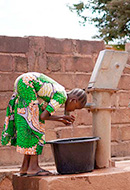Water usage
We optimise water management and ensure it is used in accordance with the best practises
The efficient management of water resources has become vital for the health of our planet. Iberdrola Group makes every effort to use water rationally and sustainably and tackle the risks related with its scarcity.

Water management
At Iberdrola, water management prioritises efficiency through controlling water use in our operations. This means we can identify room for improvement and optimise consumption, reducing waste and promoting a more sustainable use of this resource. These measures not only help to conserve water, but also contribute to environmental sustainability and operational efficiency.
At Iberdrola, we also focus on actions to improve wastewater quality. Our advanced treatment processes ensure that the water returned to the environment meets the quality parameters required by applicable regulations (even exceeding them), minimising environmental impact and promoting a cleaner and healthier water cycle.
We continually strive to improve our practices by setting water management targets. These targets guide us towards constant improvement in water use efficiency. We also have facilities that use recycled water in their operations. Recycled water plays a crucial part, enabling a more efficient and sustainable use of the resource.
Water impact and dependencies
Water risk management focuses on identifying, assessing and mitigating potential impact and dependencies, ensuring the protection of this resource and understanding how our operations can be affected by water availability and quality. This analysis enables us to develop effective strategies to reduce our dependency and ensure operational continuity. Comprehensive regulatory monitoring, as part of our certified environmental management system, allows us to identify regulatory changes that may affect water management. We also conduct studies to understand how our operations affect surrounding communities and ecosystems.
The main impact from our operations is:
- Water resource drawdown. Mainly caused by thermal generation activity.
- Changes in water quality. These are reflected in changes in the temperature of the water discharged and possible changes in chemical composition.
We constantly assess water quality and quantity in different areas of operation to ensure that quality indicators are always maintained within regulated limits.
The main dependency is on the ecosystem service of regulating the hydrological cycle, due to its impact on our thermal and hydro generation activities, and the climate regulation service of water, due to its impact on our infrastructures from storms, floods, etc.
In our biodiversity report you can find more information on how risks are identified and managed and the corresponding mitigation actions.
The following actions aimed at a more sustainable use of water stand out as the most representative:

95.73 %
of the water collected in thermal generation and cogeneration facilities returned to the environment

10.33 hm³
of water collected saved from cooling in thermal power stations

3.647 hm³
of waste water recycled in cooling processes
Fiscal year 2024 data.
Using water to generate energy
The main use of water takes place during the cooling process in the thermal generation of electricity. Our strategy for improving the efficient use of water is based on:
-
Replace the least efficient technologies with renewables and combined cycle.
- Monitor collection and discharge [PDF] External link, opens in new window.:
-
Limit the collection and consumption volume of continental waters across all technologies.
-
Avoid water collection in areas suffering water stress.
-
Assurance of water quality when discharging.
-
Reuse and recycle water within facilities.
-
-
Continually improve the processes used at the facilities for lower consumption and impact.
-
Establish and monitor the surface threshold levels and the natural flow rates in the hydroelectricity generation reservoirs.
-
Carry out awareness campaigns to achieve more efficient and responsible use of office water by employees.
The Group's changing water usage is presented below:
Evolution of the Iberdrola Group's water use
(hm³)
Note: water usage is defined as water extracted less water discharged to the natural environment.
Intensity of water usage
(m³/GWh)
Iberdrola's core policy of replacing its least efficient technologies with clean and sustainable ones, such as renewables and dry combined cycle, is the reason for the decrease in the company’s intensity of water use ratio.
Projects and preventive actions
Respect for this resource also implies the preservation of biodiversity, which is why it is so important to control water withdrawals to avoid material impacts on water ecosystems or reduce the risk of spills and, therefore, avoid contamination.
Iberdrola takes safety and containment measures to mitigate the impacts: preventive actions are carried out annually to avoid and reduce the impact of possible spills, such as the construction of tanks to collect oil in the event of a massive spill at substations and transformation centres, or the waterproofing of buckets.

SDG 6: Clean water and sanitation
We are one of the utilities with the best water productivity.

Water pollution
This resource is essential for the survival of living beings.

Water security
Climate change is undermining water security on the planet.

World Water Day
A global initiative to highlight the need to combat its scarcity.
Circular economy model at the Iberdrola Group
At Iberdrola, we work to be more respectful of nature in our three strategic sustainability areas: climate action, biodiversity protection, and circular economy.
For this reason, our sustainable business model is based on the circular economy model, a system for making the most of resources in which priority is given to reducing the use of new raw materials through efficiency in processes, product life extensions, and a firm commitment to the reuse and recycling of materials.








